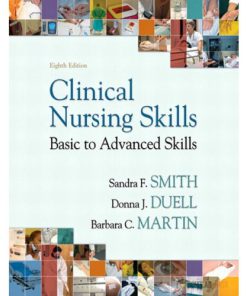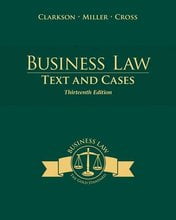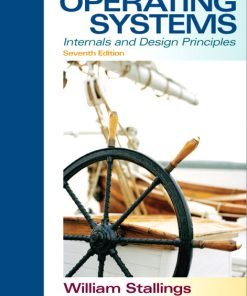Business Communication Polishing Your Professional Presence 3rd Edition Shwom Test Bank
$35.00 Original price was: $35.00.$26.50Current price is: $26.50.
Business Communication Polishing Your Professional Presence 3rd Edition Shwom Test Bank
This is completed downloadable of Business Communication Polishing Your Professional Presence 3rd Edition Shwom Test Bank

Product Details:
- ISBN-10 : 0133865614
- ISBN-13 : 978-0133865615
- Author: Barbara G. Shwom (Author), Lisa Gueldenzoph Snyder (Author)
NOTE: You are purchasing a standalone product; MyBCommLab does not come packaged with this content. If you would like to purchase both the physical text and MyBCommLab search for 0134088905 / 9780134088907 Business Communication: Polishing Your Professional Presence Plus MyBCommLab with Pearson eText — Access Card Package, 3/e
Table of Content:
-
- MyBCommLab® Improves Student Engagement Before, During, and After Class
- Business Communication
- Business Communication
- About the Authors
- Contents
- Contents
- A Word of Thanks
- Reviewers
- Accuracy Checkers
- Contributors to the Instructor’s Resources
- Graduate Assistants
- MyLab Contributors
- 1 Developing Your Professional Presence
- STUDY QUESTIONS
- Improve Your Grade!
- Chapter 1 | Introduction
- SQ1 Why is it challenging to communicate well?
- Communication is a complex process
- Communication is affected by context
- Communication is more than transmission of messages
- SQ2 What are the benefits of being a good communicator?
- Effective business communicators have a competitive edge in the job market
- Communication skills will contribute to your company’s and your own success
- Communication skills will make you a more valuable employee
- Communication skills may improve your salary
- Good communication skills can improve your personal life
- Being strategic
- Purposeful
- Being strategic
- Audience-oriented
- Persuasive
- Being professional
- Appropriate to the situation
- Clear and concise
- Ethical
- Being adaptable
- Current with technology and social media
- Choosing the best technology for the task.
- Avoiding technology traps.
- Adapting familiar technology to business use.
- Able to work with many cultures
- Collaborative
- Current with technology and social media
- End of Chapter Study Questions in Review
- SQ1 Why is it challenging to communicate well? (pages 4–6)
- SQ2 What are the benefits of being a good communicator? (pages 6–8)
- SQ3 What characteristics will help you communicate effectively? (pages 8–19)
- Visual Summary
- Key Terms
- Review Questions
- Critical Thinking Questions
- Key Concept Exercises
- SQ1Why is it challenging to communicate well? (pages 4–6)
- SQ2What are the benefits of being a good communicator? (pages 6–8)
- SQ3 What characteristics will help you communicate effectively? (pages 8–19)
- Writing Exercises
- Collaboration Exercises
- Social Media Exercises
- Speaking Exercises
- Grammar Exercises
- References
- 2 Working with Others
- Study Questions
- Improve Your Grade!
- Chapter 2 | Introduction
- SQ1 What listening skills will help you communicate better with others?
- Hearing accurately
- Comprehending and interpreting
- “Listen” to nonverbal communication
- Ask questions and paraphrase to ensure understanding
- Be aware of gender-specific communication styles
- Evaluating
- Responding
- SQ2 How can you help others listen well when you speak?
- Focus on your audience
- Share the conversation
- Use clear, concrete, unambiguous language
- Support your message with good nonverbal communication
- Avoid language that triggers a negative response
- Frame negative comments positively
- SQ3 How can you manage interpersonal conflict?
- Identify the cause of the conflict
- Competing goals
- Differences of opinion
- Faulty assumptions
- Relational issues
- Ego issues
- Select an appropriate management technique
- Identify the cause of the conflict
- SQ4 How can you improve your communication with people from different cultures?
- Understand how cultures differ
- High context versus low context
- Individualism versus collectivism
- Power distance
- Uncertainty avoidance
- Time orientation
- Develop strategies that help you communicate with diverse groups
- Understand how cultures differ
- SQ5 How can you work effectively as part of a team?
- Assemble an effective team
- Agree on team goals and standards
- Pay attention to team development and dynamics
- Develop good leadership practices
- Plan for effective meetings
- Be a good team member
- Listening for Understanding
- Framing Negative Criticism Positively
- Understanding Conflict
- Managing Cultural Diversity
- Reaping the Benefits of Teamwork
- End of Chapter Study Questions in Review
- SQ1 What listening skills will help you communicate better with others? (pages 32–38)
- SQ2 How can you help others listen well when you speak? (pages 38–41)
- SQ3 How can you manage interpersonal conflict? (pages 41–47)
- SQ4 How can you improve your communication with people from different cultures? (pages 47–51)
- SQ5 How can you work effectively as part of a team? (pages 51–58)
- Visual Summary
- Key Terms
- Review Questions
- Critical Thinking Questions
- Key Concept Excercises
- SQ1 What listening skills will help you communicate better with others? (pages 32–38)
- SQ2 How can you help others listen well when you speak? (pages 38–41)
- SQ3 How can you manage interpersonal conflict? (pages 41–47)
- SQ4 How can you improve your communication with people from different cultures? (pages 47–51)
- SQ5 How can you work effectively as part of a team? (pages 51–58)
- Writing Exercises
- Collaboration Exercises
- Social Media Exercises
- Speaking Exercises
- Grammar Exercises
- References
- 3Managing the Communication Process
- Study Questions
- Improve Your Grade!
- Chapter 3 | Introduction
- SQ1 What are the benefits of analyzing?
- Analyzing the purpose focuses the message
- Analyzing the audience helps you meet their needs
- Analyzing the content ensures a complete message
- Analyzing the medium helps you choose the best delivery option
- SQ2 What is involved in composing?
- Deciding when and where to compose
- Organizing the message
- Drafting the content
- Designing a professional format and delivery
- Email messages
- Memos
- Letters
- Voice mail messages
- SQ3 How does evaluating improve your communication?
- Evaluating content helps you achieve your purpose and outcome
- Evaluating for clarity and conciseness improves comprehension
- Evaluating for style and tone helps you project a professional image
- Evaluating for correctness increases your credibility
- Familiarize yourself with five types of errors
- Check systematically for errors
- Reviewing feedback helps you become a better communicator
- What Is the Desired Outcome?
- What Content Does the Audience Need?
- Which Medium Is Best?
- How Can I Structure My Content?
- End of Chapter Study Questions in Review
- SQ1 What are the benefits of analyzing? (pages 77–81)
- SQ2 What is involved in composing? (pages 82–90)
- SQ3 How does evaluating improve your communication? (pages 91–98)
- Visual Summary
- Key Terms
- Review Questions
- Critical Thinking Questions
- Key Concept Exercises
- SQ1 What are the benefits of analyzing? (pages 77–81)
- SQ2 What is involved in composing? (pages 82–90)
- SQ3 How does evaluating improve your communication? (pages 91–98)
- Writing Exercises
- Collaboration Exercises
- Speaking Exercises
- Social Media Exercises
- Grammar Exercises
- References
- 4 Communicating Routine Messages and Building Goodwill
- Study Questions
- Improve Your Grade!
- Chapter 4 | Introduction
- SQ1 How do you compose messages containing questions and requests?
- Decide between a direct or an indirect message
- Provide reasons for the request
- Adopt a “you” perspective and include audience benefits
- Conclude with gratitude and a call for action
- SQ2 How do you compose informational messages?
- Reply to questions with a direct answer
- Respond to customer requests and comments by creating goodwill
- Highlight key points in confirmation messages
- Organize routine announcements so they are easy to skim
- Format instructions so readers can easily follow the steps
- Keep text and IM messages short and focused
- SQ3 What kinds of messages build goodwill in business relationships?
- Thank-you messages
- Congratulatory messages
- Sympathy messages
- “For-your-information” messages
- End of Chapter Study Questions in Review
- SQ1 How do you compose messages containing questions and requests? (pages 116–120)
- SQ2 How do you compose informational messages? (pages 120–127)
- SQ3 What kinds of messages build goodwill in business relationships? (pages 128–132)
- Visual Summary
- Key Terms
- Review Questions
- Critical Thinking Questions
- Key Concept Exercises
- SQ1 How do you compose messages containing questions and requests? (pages 116–120)
- SQ2 How do you compose informational messages? (pages 120–127)
- SQ3 What kinds of messages build goodwill in business relationships? (pages 128–132)
- Writing Exercises
- Collaboration Exercises
- Social Media Exercises
- Speaking Exercises
- Grammar Exercises
- References
- 5 Communicating Persuasive Messages
- Study Questions
- Improve Your Grade!
- Chapter 5 | Introduction
- SQ1 How can the ACE process help you persuade your audience?
- Analyzing helps you plan your message
- Analyze your purpose, desired outcome, and business result
- Analyze your audiences’ and stakeholders’ needs
- Analyze medium choices
- Composing implements the persuasive plan
- Evaluating helps you review the draft for effectiveness
- Analyzing helps you plan your message
- SQ2 What are the basic elements of persuasion?
- Building credibility
- Constructing a logical argument
- Appealing to your audience’s emotions
- Appeal to your audience’s emotional and psychological needs
- Make appeals based on widely studied psychological principles
- Show your own emotional commitment
- Use storytelling and powerful language to make evidence compelling
- SQ3 What types of business messages typically require persuasion?
- Recommendations for action
- Requests for favors
- Analyze
- Compose
- Evaluate
- Persuasive customer claims
- Analyze
- Compose
- Evaluate
- Sales messages
- SQ4 How can you use persuasion to improve teamwork and collaboration?
- Use persuasion to motivate others
- Incorporate persuasion into the team decision-making process
- Persuading Lenders to Fund a Loan
- Identifying Benefits and Objections
- Building Credibility through a Website
- Writing a Persuasive Sales Message
- End of Chapter Study Questions in Review
- SQ1 How can the ACE process help you persuade your audience? (pages 146–151)
- SQ2 What are the basic elements of persuasion? (pages 151–158)
- SQ3 What types of business messages typically require persuasion? (pages 159–166)
- SQ4 How can you use persuasion to improve teamwork and collaboration? (pages 167–168)
- Visual Summary
- SQ1 How can the ACE process help you persuade your audience?
- SQ2 What are the basic elements of persuasion?
- SQ3 What types of business messages typically require persuasion?
- SQ4 How can you use persuasion to improve teamwork and collaboration?
- Key Terms
- Review Questions
- Critical Thinking Questions
- Key Concept Exercises
- SQ1 How can the ACE process help you persuade your audience? (pages 146–151)
- SQ2 What are the basic elements of persuasion? (pages 151–158)
- SQ3 What types of business messages typically require persuasion? (pages 159–166)
- SQ4 How can you use persuasion to improve teamwork and collaboration? (pages 167–168)
- Writing Exercises
- Collaboration Exercises
- Social Media Exercises
- Speaking Exercises
- Grammar Exercises
- References
- 6 Communicating Bad News
- Study Questions
- Improve Your Grade!
- Chapter 6 | Introduction
- SQ1 How should you analyze and plan a bad-news message?
- Ask questions that help you develop content
- Select the best medium to achieve your goal
- SQ2 What are effective strategies for composing bad-news messages?
- Decide where to state the bad news
- Phrase the bad news clearly
- Soften the bad news
- Develop an effective buffer
- Position good news ahead of bad news
- Subordinate the bad news
- Use positive or neutral language
- Close the message positively
- SQ3 How should you evaluate bad-news messages?
- Evaluate the message’s clarity, honesty, and sense of goodwill
- Evaluate the business result
- SQ4 What types of bad-news messages are common in business?
- Denying requests or turning down invitations
- Denying customer claims
- Rejecting recommendations or proposals
- Acknowledging mistakes or problems
- Communicating performance problems
- Communicating negative change
- Softening the Impact of Bad News
- Bad News in the Mail
- Bad News from the Professor
- As a Customer, How Do You Feel?
- End of Chapter Study Questions in Review
- SQ1 How should you analyze and plan a bad-news message? (pages 186–189)
- SQ2 What are effective strategies for composing bad-news messages? (pages 189–195)
- SQ3 How should you evaluate bad-news messages? (pages 195–196)
- SQ4 What types of bad-news messages are common in business? (pages 196–204)
- Visual Summary
- Key Terms
- Review Questions
- Critical Thinking Questions
- Key Concept Exercises
- SQ1 How should you analyze and plan a bad-news message? (pages 186–189)
- SQ2 What are effective strategies for composing bad-news messages? (pages 189–195)
- SQ3 How should you evaluate bad-news messages? (pages 195–196)
- SQ4 What types of bad-news messages are common in business? (pages 196–204)
- Writing Exercises
- Collaboration Exercises
- Social Media Exercises
- Speaking Exercises
- Grammar Exercises
- References
- 7 Using Social Media in Business
- Study Questions
- Improve Your Grade!
- Chapter 7 | Introduction
- SQ1 How can businesses plan, implement, and evaluate a social media strategy?
- Analyze goals, audience, and social media options to develop a social media strategy
- Compose effective social media content for each platform
- Evaluate the success of your social media efforts
- SQ2 What are good practices for composing and publishing social media content?
- Facebook: Post strategically
- Twitter: Be short and focused
- Pinterest: Engage with visual content
- Blogs: Offer insights, advice, and information
- SQ3 How can businesses use social media to accomplish specific communication goals?
- Use social media to build goodwill
- Provide quick responses to questions and concerns
- Provide useful information that audiences want and need
- Build a positive online community
- Use social media to persuade
- Build credibility by providing valuable content
- Develop a strategy to motivate action
- Use persuasive techniques to appeal to emotion
- Control the spread of bad news through social media
- have a plan in place
- Respond quickly
- Respond genuinely
- Use social media to build goodwill
- SQ4 How can you, as an employee, use social media responsibly?
- Follow guidelines to avoid damage to your and your company’s reputations
- Developing a social media strategy
- Composing Social Media Content That Engages the Audience
- Controlling the Spread of Bad News Using Social Media
- End of Chapter Study Questions in Review
- SQ1 How can businesses plan, implement, and evaluate a social media strategy? (pages 220–225)
- SQ2 What are good practices for composing and publishing social media content? (pages 225–231)
- SQ3 How can businesses use social media to accomplish specific communication goals? (pages 232–242)
- SQ4 How can you, as an employee, use social media responsibly? (pages 242–243)
- Visual Summary
- Key Terms
- Review Questions
- Critical Thinking Questions
- Key Concepts Exercises
- SQ1 How can businesses plan, implement, and evaluate a social media strategy? (pages 220–225)
- SQ2 What are good practices for composing and publishing social media content? (pages 225–231)
- SQ3 How can businesses use social media to accomplish specific communication goals? (pages 232–242)
- SQ4 How can you, as an employee, use social media responsibly? (pages 242–243)
- Writing Exercises
- Collaboration Exercises
- Social Media Exercises
- Speaking Exercises
- Grammar Exercises
- References
- 8 Finding and Evaluating Business Information
- Study Questions
- Improve Your Grade!
- Chapter 8 | Introduction
- SQ1 How do you determine what information you need?
- Analyze the research question and topic
- Identify audience concerns and needs
- Establish the scope of the research
- Define research activities
- Develop a work plan
- SQ2 How do you conduct research in print and online sources?
- Gather relevant print and electronic files
- Search the web strategically
- Use an online index or database to find articles and business data
- Use a library or bookseller to find relevant books
- Follow leads in good sources
- Evaluate your sources for credibility
- SQ3 How do you conduct primary research?
- Conduct survey research to gather information that is easy to compare
- Choose which people to survey
- Decide on a survey medium
- Compose effective survey questions
- Analyze, interpret, and evaluate results
- Conduct interview research to gather in-depth information
- Conduct observational research to understand how people act
- Conduct survey research to gather information that is easy to compare
- SQ4 How can you use social media in your research?
- Search for experts
- Post questions to your network and beyond
- Gather anecdotal evidence
- SQ5 How can you effectively organize the results of your research?
- Build your reference list as you research
- Organize documents and notes on your computer and “in the cloud”
- Organize your findings by research questions
- Receiving a Research Assignment
- Developing a Work Plan
- Researching Online Sources
- Conducting Primary Research
- Organizing Research Results
- End of Chapter Study Questions in Review
- SQ1 How do you determine what information you need? (pages 258–263)
- SQ2 How do you conduct research in print and online sources? (pages 263–270)
- SQ3 How do you conduct primary research? (pages 271–278)
- SQ4 How can you use social media in your research? (pages 278–279)
- SQ5 How can you effectively organize the results of your research? (pages 279–282)
- Visual Summary
- Key Terms
- Review Questions
- Critical Thinking Questions
- Key Concept Exercises
- SQ1 How do you determine what information you need? (pages 258–263)
- SQ2 How do you conduct research in print and online sources? (pages 263–270)
- SQ3 How do you conduct primary research? (pages 271–278)
- SQ4 How can you use social media in your research? (pages 278–279)
- SQ5 How can you effectively organize the results of your research? (pages 279–282)
- Writing Exercises
- Collaboration Exercises
- Social Media Exercises
- Speaking Exercises
- Grammar Exercises
- References
- 9 Preparing Persuasive Business Proposals
- Study Questions
- Improve Your Grade!
- Chapter 9 | Introduction
- SQ1 How do you use ace to prepare an effective proposal?
- Analyze: Understand the purpose, context, and content
- Purpose
- Context
- Content
- Compose: Develop persuasive content
- Articulate the problem, need, or opportunity
- Present a compelling recommendation with supporting details
- Identify the outcomes and benefits
- Establish feasibility and credibility
- Request action
- Evaluate: Assess the effectiveness of the proposal
- Analyze: Understand the purpose, context, and content
- SQ2 What types of business proposals should you be prepared to write?
- Proposals for action or change
- Solicited sales proposals
- Unsolicited sales proposals
- Grant proposals and other proposals for funding
- SQ3 How do you structure and format a formal proposal?
- Read RFPs carefully to identify content requirements
- Structure a formal proposal like a formal report
- Use proposal-writing software to increase efficiency
- Brainstorming Content for a Proposal
- What to Include and What to Leave Out
- Deciding on a Goal and Choosing the Best Format
- End of Chapter Study Questions in Review
- SQ1 How do you use ACE to prepare an effective proposal? (pages 298–303)
- SQ2 What types of business proposals should you be prepared to write? (pages 303–312)
- SQ3 How do you structure and format a formal proposal? (pages 313–319)
- Visual Summary
- Key Terms
- Review Questions
- Critical Thinking Questions
- Key Concept Exercises
- SQ1How do you use ACE to prepare an effective proposal? (pages 298–303)
- SQ2What types of business proposals should you be prepared to write? (pages 303–312)
- SQ3How do you structure and format a formal proposal? (pages 313–319)
- Writing Exercises
- Collaboration Exercises
- Social Media Exercises
- Speaking Exercises
- Grammar Exercises
- References
- 10 Preparing Business Reports
- Study Questions
- Improve Your Grade!
- Chapter 10 | Introduction
- SQ1 How can ACE help you write a business report?
- Analyze to understand purpose and report type
- Analyze to understand audience needs
- Analyze to choose the best medium
- Compose your report to meet audience expectations
- Compose using an objective and easy-to-read style
- Evaluate by reviewing on your own and getting feedback from others
- SQ2 What types of short, routine reports are typical in business?
- Progress reports
- Meeting minutes
- Trip reports
- Feasibility reports
- SQ3 How should you structure longer, formal reports for print and online distribution?
- Organize the report into useful sections
- Design the report for your audience and purpose
- Choose the best electronic format for online distribution
- SQ4 What guidelines should you follow for writing report decks?
- Understand why and when to use report decks
- Design the deck effectively
- Design the deck content to be easy to follow
- SQ5 How do you integrate tables and graphs into reports?
- Choose the best form of display: table or graph
- Choose the best type of graph
- Design graphs and tables to communicate
- Integrate data displays within the text
- SQ6 How should you document your research?
- Determine what needs to be documented
- Prepare the documentation
- Structuring the Report’s Findings
- Phrasing a Conclusion Accurately
- End of Chapter Study Questions in Review
- SQ1How can ACE help you write a business report? (pages 332–337)
- SQ2What types of short, routine reports are typical in business? (pages 338–343)
- SQ3How should you structure longer, formal reports for print and online distribution? (pages 344–364)
- SQ4What guidelines should you follow for writing report decks? (pages 365–369)
- SQ5How do you integrate tables and graphs into reports? (pages 369–376)
- SQ6How should you document your research? (pages 377–379)
- Visual Summary
- Key Terms
- Review Questions
- Critical Thinking Questions
- Key Concept Exercises
- SQ1 How can ACE help you write a business report? (pages 332–337)
- SQ2 What types of short, routine reports are typical in business? (pages 338–343)
- SQ3 How should you structure longer, formal reports for print and online distribution? (pages 344–364)
- SQ4 What guidelines should you follow for writing report decks? (pages 365–369)
- SQ5 How do you integrate tables and graphs into reports? (pages 369–376)
- SQ6 How should you document your research? (pages 377–379)
- Writing Exercises
- Collaboration Exercises
- Social Media Exercises
- Speaking Exercises
- Grammar Exercises
- References
- 11Preparing and Delivering Business Presentations
- Study Questions
- Improve Your Grade!
- Chapter 11 | Introduction
- SQ1 What do you analyze when planning a business presentation?
- Analyze your purpose and desired outcome: Why are you presenting?
- Analyze your audience: Who will be listening, and what do they care about?
- Analyze your message: What will you say to achieve your desired outcome?
- Analyze your setting: Where will you present?
- Analyze your medium options: How will you deliver your message?
- SQ2 How do you compose the presentation?
- Organize the content
- Compose an opening that engages the audience
- Establish rapport.
- Capture attention.
- Motivate your audience to care.
- Provide a framework or map.
- Organize the middle of the presentation to be easy to understand
- Focus on points that are meaningful to the audience.
- Limit the number of key points.
- Present your information using a recognizable pattern.
- Compose a memorable conclusion
- Compose an opening that engages the audience
- Identify the role that slides will play
- Stand-alone presentations
- Visual aid presentations
- Create a storyboard
- Develop a template
- Design individual slides
- Text slides
- Data slides
- Evaluate your slides in a practice session
- Are the slides easy to present?
- Are animations effective?
- Create effective handouts
- Organize the content
- SQ3 How do you deliver and evaluate the presentation?
- Set the stage
- Control your body
- Use your voice effectively
- Present your visuals effectively
- Coordinate with your team
- Evaluate the audience’s response
- SQ4 How do you handle questions and answers?
- Plan for a question-and-answer (Q&A) session
- Decide how and when you will handle Q&A
- Anticipate questions and plan short answers
- Decide how your team will handle questions
- Answer questions skillfully
- Give a three-part answer
- Break complex questions into parts
- Be honest
- Avoid being defensive or dismissive
- Plan for a question-and-answer (Q&A) session
- SQ5 How do you adapt your approach for online presentations?
- In a live online presentation, manage the audience experience
- In a podcast, provide content that offers lasting value
- Planning a Presentation
- Questions for Reviewing the Culinary Adventure Tour Presentation
- End of Chapter Study Questions in Review
- SQ1 What do you analyze when planning a business presentation? (pages 398–402)
- SQ2 How do you compose the presentation? (pages 403–423)
- SQ3 How do you deliver and evaluate the presentation? (pages 423–427)
- SQ4 How do you handle questions and answers? (pages 428–429)
- SQ5 How do you adapt your approach for online presentations? (pages 429–433)
- Visual Summary
- Key Terms
- Review Questions
- Critical Thinking Questions
- Key Concept Exercises
- SQ1 What do you analyze when planning a business presentation? (pages 398–402)
- SQ2 How do you compose the presentation? (pages 403–423)
- SQ3 How do you deliver and evaluate the presentation? (pages 423–427)
- SQ4 How do you handle questions and answers? (pages 428–429)
- SQ5 How do you adapt your approach for online presentations? (pages 429–433)
- Writing Exercises
- Collaboration Exercises
- Social Media Exercises
- Speaking Exercises
- Grammar Exercises
- References
- 12 Communicating Your Professional Brand: Social Media, Résumés, Cover Letters, and Interviews
- Study Questions
- Improve Your Grade!
- Chapter 12 | Introduction
- SQ1 How do you polish your professional presence for a job search?
- Analyze your career goals, strengths, and skills
- Analyzing career goals
- Analyzing strengths and skills
- Compose your brand message and strategic social media content
- Composing your brand message
- Composing strategic social media content
- Making yourself visible
- Making yourself valuable
- Evaluate your virtual professional image
- Analyze your career goals, strengths, and skills
- SQ2 How do you compose an effective résumé?
- Analyze your options for organizing your résumé
- Compose effective résumé content
- Evaluate your content and design
- SQ3 How do you find job opportunities and submit applications?
- Analyze your options for finding job opportunities
- Compose persuasive cover letters
- Analyze the position requirements
- Compose persuasive content
- Evaluate content and format
- Select a medium for submission and follow up as necessary
- Evaluate your application submission options
- Follow up as necessary
- Analyze your options for finding job opportunities
- SQ4 How do you prepare for a job interview?
- Analyze how to benefit from different types of interviews
- Compose good answers—and good questions
- Evaluate your professional appearance
- SQ5 How can you make a positive impression during and after an interview?
- Project a professional presence
- Compose effective post-interview messages
- Compose thank-you messages
- Compose follow-up messages
- Evaluate your performance
- Updating a Résumé
- Drafting a Cover Letter
- Composing Answers to Standard Interview Questions
- End of Chapter Study Questions in Review
- SQ1 How do you polish your professional presence for a job search? (pages 452–459)
- SQ2 How do you compose an effective résumé? (pages 459–467)
- SQ3 How do you find job opportunities and submit applications? (pages 468–475)
- SQ4 How do you prepare for a job interview? (pages 476–481)
- SQ5 How can you make a positive impression during and after an interview? (pages 481–490)
- Visual Summary
- Key Terms
- Review Questions
- Critical Thinking Questions
- Key Concept Exercises
- SQ1 How do you polish your professional presence for a job search? (pages 452–459)
- SQ2 How do you compose an effective résumé? (pages 459–467)
- SQ3 How do you find job opportunities and submit applications? (pages 468–475)
- SQ4 How do you prepare for a job interview? (pages 476–481)
- SQ5 How can you make a positive impression during and after an interview? (pages 481–490)
- Writing Exercises
- Collaboration Exercises
- Social Media Exercises
- Speaking Exercises
- Grammar Exercises
- References
- Appendix A Formats for Business Documents
- Email
- Email formatting guidelines
- Email report format
- Memos
- Memo formatting guidelines
- Letters
- Letter formatting guidelines
- Envelope format
- Abbreviations of states, territories, and provinces
- Abbreviations of commonwealths/territories
- Abbreviations of military “states”
- Reports
- Reference
- Email formatting guidelines
- Email
- Appendix B Documentation and Reference Styles
- APA in-text citations
- Paraphrased content
- Single-author paraphrased source
- Multiple-author paraphrased source
- works with no identified author
- Multiple sources used to support one statement
- Multiple sources by the same author to support one statement
- Multiple sources by the same author published in the same year
- Personal communication
- Quoted content
- Single-author quoted source
- Multiple-author quoted source
- Quotations with words omitted
- Paraphrased content
- APA reference list
- Authors
- Year of publication
- Name of work
- Articles and blog posts
- Books, videos, podcasts, etc.
- Journals and other periodicals
- Publication information
- Journal and other periodical articles
- Books and e-books
- websites
- Other types of sources
- Sample APA reference page
- Sample APA documentation in presentation files
- MLA in-text citations
- Paraphrased content
- Single-author source
- works with no identified author
- Multiple-author source
- Multiple sources used to support one statement
- Multiple sources by the same author to support one statement
- Personal communication
- Quoted content
- Single-author quoted source
- Multiple-author quoted source
- Quotations with words omitted
- Paraphrased content
- MLA works cited list
- Authors
- Name of work
- Publication information and medium of publication
- Journal or other periodical articles
- Books and e-books
- Web-based sources
- Supplemental information
- Other types of sources
- Sample MLA works cited page
- Sample MLA documentation in presentation files
- APA in-text citations
- Appendix C Grammar, Punctuation, Mechanics, and Conventions
- Sentence-level skills diagnostic test
- Use and Formation of Nouns and Pronouns
- Use and Formation of Adjectives and Adverbs
- Sentence Fragments, Run-On (Fused) Sentences, and Comma Splices
- Subject–Verb Agreement and Pronoun–Antecedent Agreement
- Commas
- Commas and Semicolons
- Other Punctuation Marks
- Capitalization
- Numbers
- Spelling
- Sentence-level skills assessment
- 1. Sentences
- 1.1. Parts of Speech
- 1.1.1. Naming Words: Nouns and Pronouns
- 1.1.2. Action and Being Words: Verbs
- 1.1.3. Modifying Words: Adjectives and Adverbs
- 1.1.4. Connecting Words: Prepositions and Conjunctions
- 1.1.5. Exclaiming Words: Interjections
- 1.2. Sentence Parts and Patterns
- 1.2.1. Subjects and Predicates
- 1.2.2. Phrases and Clauses
- 1.2.3. Sentence Types: Simple, Compound, Complex, Compound-Complex
- 1.3. Common Sentence Errors
- 1.3.1. Sentence Fragments
- 1.3.2. Run-on (Fused) Sentences and Comma Splices
- 1.3.3. Subject–Verb Agreement
- 1.3.4. Pronoun–Antecedent Agreement
- 1.3.5. Vague Pronoun Reference
- 1.1. Parts of Speech
- 2. Punctuation
- 2.1. End Punctuation
- 2.1.1. Question Marks
- 2.1.2. Periods
- 2.1.3. Exclamation Points
- 2.2. Commas
- 2.2.1. Between Clauses
- 2.2.2. Between Adjectives
- 2.2.3. Between Items in a Series
- 2.2.4. Around Clauses, Phrases, or Words
- 2.3. Semicolons
- 2.3.1. Joining Independent Clauses
- 2.3.2. Between Items in a Series
- 2.4. Colons
- 2.4.1. Preceding a List
- 2.4.2. Preceding an Explanation or Illustration
- 2.4.3. Preceding a Rule, Formal Quotation, or Subtitle
- 2.5. Quotation Marks and Italics
- 2.5.1. Quotation Marks
- 2.5.2. Italics
- 2.6. Apostrophes
- 2.6.1. Possessive Case
- 2.6.2. Contractions
- 2.7. Other Punctuation Marks
- 2.7.1. Parentheses, Dashes, Brackets, and Ellipses
- 2.7.2. Hyphens
- 2.1. End Punctuation
- 3. Mechanics and Business Conventions
- 3.1. Capitalization
- 3.1.1. First Words
- 3.1.2. Proper Nouns vs. Common Nouns
- 3.2. Numbers
- 3.2.1. Words vs. Figures
- 3.2.2. Consecutive Numbers
- 3.2.3. Related Numbers
- 3.2.4. Indefinite or Approximate Numbers
- 3.2.5. Numbers at the Beginning of Sentences
- 3.2.6. Fractions and Ordinals
- 3.2.7. Decimals and Percentages
- 3.2.8. Money
- 3.2.9. Dates and Times
- 3.2.10. Measurements and Compound-Number Adjectives
- 3.2.11. Addresses and Telephone Numbers
- 3.3. Abbreviations, Acronyms, and Initialisms
- 3.3.1. Definitions, Forms, and Functions
- 3.3.2. When to Use Abbreviations—or Not
- 3.3.3. Spacing and Punctuation of Abbreviations
- 3.1. Capitalization
- 4. Spelling
- 4.1. Four Rules of Thumb for Adding Endings
- 4.2. Memory Aids for ie and ei
- 4.3. Commonly Misspelled Words
- 4.4. Commonly Confused Words
- 1. Sentences
- Sentence-level skills diagnostic test
- Appendix D Answer Key to Grammar Exercises
- Appendix E Proofreader’s Marks
- Proofreading tips
- Correction symbols
- Glossary
- Index
- A
- B
- C
- D
- E
- F
- G
- H
- I
- J
- K
- L
- M
- N
- O
- P
- Q
- R
- S
- T
- U
- V
- W
- X
- Y
- Z
People Also Search:
business communication polishing your professional presence 3rd
business communication polishing your professional presence 3rd edition
business communication polishing your professional presence 3rd edition pdf
business communication polishing your professional presence 3rd download scribd
business communication polishing your professional presence 3rd test bank download pdf
Related products
Test Bank
Test Bank for Clinical Immunology and Serology A Laboratory Perspective, 3rd Edition: Stevens
Test Bank
Test Bank for Operating Systems: Internals and Design Principles, 7th Edition: William Stallings











